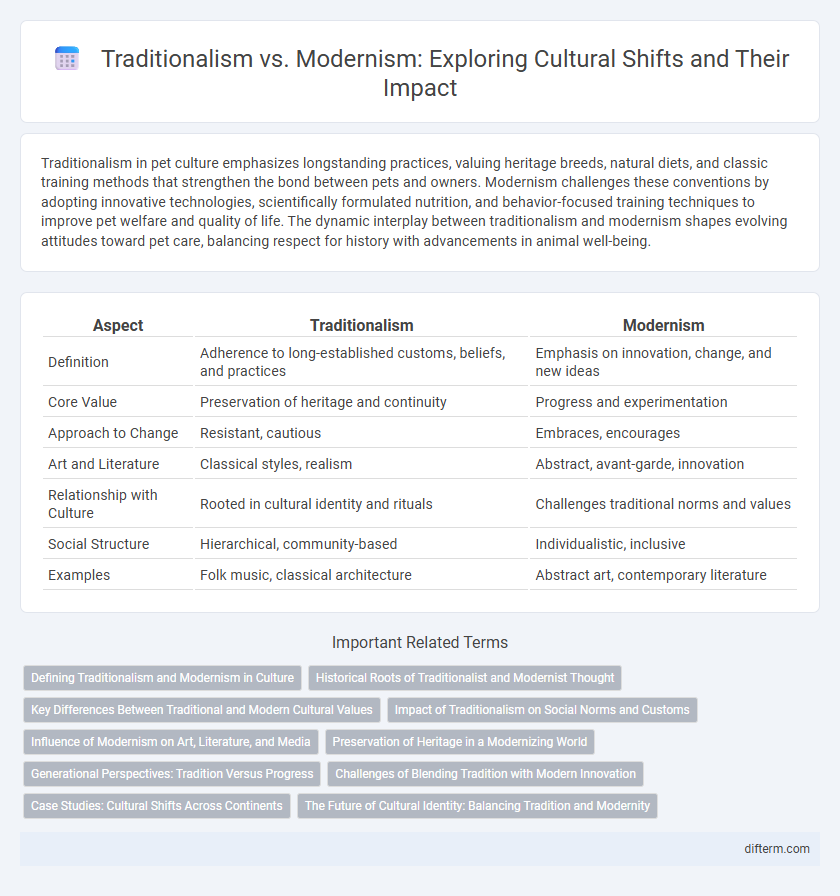Traditionalism in pet culture emphasizes longstanding practices, valuing heritage breeds, natural diets, and classic training methods that strengthen the bond between pets and owners. Modernism challenges these conventions by adopting innovative technologies, scientifically formulated nutrition, and behavior-focused training techniques to improve pet welfare and quality of life. The dynamic interplay between traditionalism and modernism shapes evolving attitudes toward pet care, balancing respect for history with advancements in animal well-being.
Table of Comparison
| Aspect | Traditionalism | Modernism |
|---|---|---|
| Definition | Adherence to long-established customs, beliefs, and practices | Emphasis on innovation, change, and new ideas |
| Core Value | Preservation of heritage and continuity | Progress and experimentation |
| Approach to Change | Resistant, cautious | Embraces, encourages |
| Art and Literature | Classical styles, realism | Abstract, avant-garde, innovation |
| Relationship with Culture | Rooted in cultural identity and rituals | Challenges traditional norms and values |
| Social Structure | Hierarchical, community-based | Individualistic, inclusive |
| Examples | Folk music, classical architecture | Abstract art, contemporary literature |
Defining Traditionalism and Modernism in Culture
Traditionalism in culture emphasizes the preservation of customs, beliefs, and practices passed down through generations, often valuing continuity, heritage, and social stability. Modernism, by contrast, embraces innovation, experimentation, and a break from established conventions to reflect contemporary experiences and progressive ideas. These opposing cultural paradigms shape societal values, artistic expressions, and collective identities by negotiating the balance between historical legacy and transformative change.
Historical Roots of Traditionalist and Modernist Thought
Traditionalist thought traces its historical roots to pre-industrial societies that emphasize continuity, religious values, and social hierarchies, drawing heavily from classical philosophy and indigenous customs. Modernist thought emerged during the Enlightenment and Industrial Revolution, advocating reason, scientific progress, individualism, and secularism as responses to traditional constraints. The intellectual divide reflects a broader cultural tension between preserving inherited values and embracing transformative innovation in societal structures.
Key Differences Between Traditional and Modern Cultural Values
Traditional cultural values emphasize community, heritage, and the preservation of long-established customs, prioritizing family bonds and social cohesion. Modern cultural values focus on individualism, innovation, and adaptability, encouraging personal freedom and technological progress. The key differences lie in the balance between collective continuity and personal autonomy, shaping societal norms and behavioral expectations.
Impact of Traditionalism on Social Norms and Customs
Traditionalism profoundly shapes social norms and customs by reinforcing long-established rituals, values, and behaviors that provide a sense of identity and continuity within communities. It often sustains hierarchical structures and gender roles, influencing family dynamics and communal responsibilities. The persistence of traditionalist values can both preserve cultural heritage and challenge social adaptation in rapidly changing societies.
Influence of Modernism on Art, Literature, and Media
Modernism profoundly reshaped art, literature, and media by challenging conventional forms and embracing innovation, abstraction, and experimentation. It introduced fragmented narratives, stream-of-consciousness writing, and abstract visual styles that broke away from traditional realism and linear storytelling. The influence of modernism encouraged creators to explore subjective experiences, question established norms, and reflect the complexities of the rapidly changing 20th-century society.
Preservation of Heritage in a Modernizing World
Traditionalism emphasizes the preservation of cultural heritage through rituals, language, and crafts deeply rooted in history, ensuring that identity and values are passed down intact. Modernism challenges this by integrating innovation and global influences, fostering cultural evolution while often risking homogenization. Balancing these forces requires adaptive strategies that protect heritage sites and practices while embracing sustainable modernization to keep traditions relevant in contemporary society.
Generational Perspectives: Tradition Versus Progress
Generational perspectives on culture reveal a dynamic tension between traditionalism and modernism, with older generations often emphasizing the preservation of established customs and values, while younger cohorts advocate for progress and innovation. This intergenerational dialogue shapes societal evolution, reflecting differing priorities in identity, technology adoption, and social norms. Understanding these contrasting viewpoints is crucial for navigating cultural transformation and fostering intergenerational cohesion.
Challenges of Blending Tradition with Modern Innovation
Balancing traditional cultural values with modern innovation presents challenges such as preserving historical identity while embracing technological advancements. Conflicts often arise when modern practices disrupt established customs, leading to social resistance and identity crises. Successful integration requires adaptive frameworks that respect heritage while fostering creativity and progress.
Case Studies: Cultural Shifts Across Continents
Traditionalism and modernism manifest distinctly across continents, illustrated by case studies such as Japan's preservation of Shinto rituals amid technological advancement and India's blend of caste customs with rapid urbanization. Africa's evolving cultural landscape highlights tensions between ancestral heritage and contemporary African identities shaped by globalization and digital media. These cultural shifts reveal how societies negotiate identity, continuity, and change in response to global influences and local realities.
The Future of Cultural Identity: Balancing Tradition and Modernity
The future of cultural identity hinges on harmonizing traditional values with modern innovations to maintain a dynamic yet rooted social fabric. Embracing digital advancements and global connectivity while preserving indigenous languages, rituals, and craftsmanship ensures cultural continuity amid rapid change. This balance fosters resilient identities that adapt without eroding the historical and communal essence defining diverse societies.
Traditionalism vs Modernism Infographic

 difterm.com
difterm.com